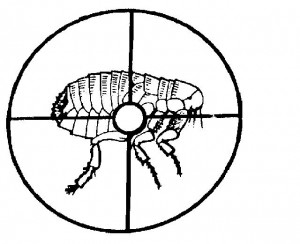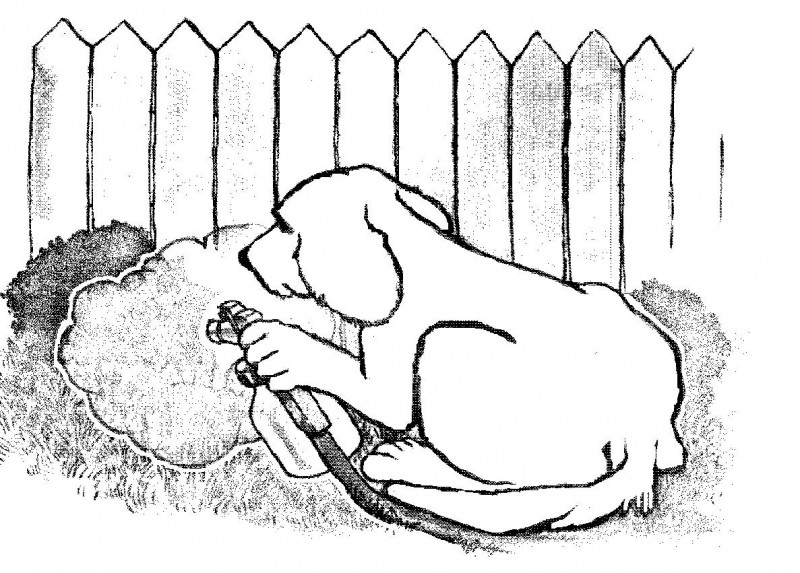
Warm weather is here, and once again it looks as though conditions are prime for another bumper crop of fleas.
Fleas are a severe problem to our pets. They cause flea allergy in many dogs and cats, a skin disease that causes intense itching, hair loss, and broken skin. Fleas can also carry and transmit tapeworms, most often seen as small rice-like worms.
Fleas are a hardy and prolific insect, and sometimes can seem to be impossible to control, but with knowledge of our enemy and a complete flea control plan, we can very effectively minimize our flea problems.
THE FLEA LIFE CYCLE

Fleas have a flexible life cycle that allows them to survive in both good and bad times. Fleas can go from egg to larvae to pupa to adult in as little as two weeks, in favorable conditions. A female flea may lay over 1,000 eggs during her lifetime. Further, only one of the four life cycle stages, the adult, actually lives on our pets.
The adult stage accounts for only 5% of total fleas in an area, the other 95% live away from the host. So it is clear, in order to control fleas, we must control fleas in the area surrounding our pets (the house and yard) as well as those fleas on our pet.
Once adult fleas find a host, they stay with them. They feed, and reproduce on their host. The eggs laid on the host fall off and spread wherever the pet goes, starting the life cycle again.
NEW CONTROL CONCEPTS
In the last few years, several excellent new products have become available, making flea control a much more manageable undertaking. These new products offer control of fleas on the pet as well as in the environment. The following is a short description of our recommended products.
Comfortis™ (Spinosad) and Trifexis™ (spinosad + milbemycin oxime)
Comfortis™ is an FDA approved, chewable, beef-flavored tablet that kills fleas and prevents flea infestations on dogs and cats for a full month. Comfortis is palatable, easy to give and starts to kill fleas in 30 minutes. This kills fleas before they can lay eggs and contaminate the environment with eggs and immature forms. Comfortis™ has be demonstrated to be safe for dogs and puppies 14 weeks and older.
With Comfortis™, you can play with your dog immediately after treatment. No need to isolate pets. Just treat and play. Because Comfortis™ is administered orally, there’s no risk of application site reactions, stained carpet or upholstery, and can’t be rubbed or shaken off.
Spinosad is the active ingredient in Comfortis chewable tablets. Spinosad is environmentally friendly. The introduction of spinosad for use in agriculture resulted in the receipt of a Presidential Green Chemistry Challenge Award in 1999 by the U.S. Environmental Protection Agency.
Trifexis is also a monthly, chewable tablet which contains spinosad, but also contains milbemycin oxime. The addition of milbemycin oxime adds the benefits of heartworm prevention, as well as the control of three common intestinal parasites: roundworms, hookworms and, whipworms.
The most common adverse reaction for these medications recorded during clinical trials was vomiting. Other adverse reactions were decreased appetite, lethargy or decreased activity, diarrhea, cough, increased thirst, vocalization, increased appetite, redness of the skin, hyperactivity and excessive salivation.
Vectra3D® (Dinotefuran, Pyriproxyfen, Permethrin) Dogs only
Vectra 3D is a newer topical liquid with an innovative applicator tube, which makes it easy to apply the product to the skin of dogs. It is quick drying, non-greasy and water resistant.
The product offers 6-way protection: it repels and kills fleas, ticks, mosquitoes, lice, sand flies and mites. It gives quick onset of activity within 2 hours and kills fleas in 6 hours. The product is used once a month.
Vectra 3D repels and kills ticks that may cause Lyme disease, Rocky Mountain spotted fever, babesiosis, ehrlichiosis, bartonellosis, hepatozoonosis and anaplasmosis.
Vectra 3D can be used on puppies over 7 weeks of age. It cannot be used on cats.
Frontline® Frontline Plus® (Fipronil, Fipronil plus (S)-methoprene)
Frontline and Frontline Plus are insecticide products that offer very good flea and tick control for cats and dogs. It comes in two forms; a spray and a drop on formulation. The active ingredient in Frontline is fipronil. Fipronil, is stored under your pet’s skin, in the oil glands, so FRONTLINE continuously reapplies to the skin and hair through the hair follicles making it waterproof.
Frontline Plus contains an extra ingredient, (S)-methoprene. Frontline Plus not only kills adult fleas, but also breaks the flea life cycle by killing their eggs and larvae, preventing re-infestation.
Both forms give long term control, and do not easily wash off the pet. Frontline Plus is applied as a few drops of liquid between the shoulder blades. All forms of Frontline should be reapplied monthly.
When properly applied, Frontline kills 96% of fleas on the pet within 24 hours, and keeps fleas and ticks off the pet for at least one month. Fleas do not need to bite the pet to be killed and thus this product is a good choice for pets with allergies to fleas. Fleas are killed before they can feed and reproduce, halting the life cycle.
Frontline has a wide safety margin, and can used be on dogs, cats, puppies, and kittens.
Frontline is effective as a preventative or as treatment for an existing infestation.
Revolution® (selamectin)
Revolution enters the bloodstream through the skin. Concentrations of Revolution in the blood and tissues prevent heartworm disease and prevent and treat roundworm and hookworm infections. Revolution selectively redistributes from the blood to the skin and other tissues, where it provides protection against fleas, flea eggs, and ear mites.
What about over the counter products?
There are many other products on the market for control of fleas. Unfortunately over the counter products tend to be much less effective than the products listed above. Some can be quite dangerous to your pet. Many permrethrin based products can cause neurologic toxicities. Over the counter products labeled for dogs can cause severe illness or death in cats. Please call Twin Maples for any questions you may have regarding flea and tick control products before using on your pet.
CONTROL OF FLEAS IN THE HOME
Use of the newer flea control products mentioned above may make home treatment unnecessary. However, if you have a pre-existing flea problem in your home, you may need to treat your home for fleas. Excellent cleaning, along with at least yearly steam cleaning of carpeting can help reduce numbers of flea eggs and immature forms in the home. In cases where fleas are already established in the home, we would also recommend treating the inside of the home with a good flea control product. It is often most effective to contract with a reputable pest control company.
There are two general types of flea control products for use in the home, insecticides, and growth inhibitors. Insecticides kill adult fleas and larval stages, but are not effective against eggs and pupal forms. Most flea insecticide products now available contain either natural or synthetic pyrethrins, derivatives of the chrysanthemum plant, and are quite safe to people and pets. Hormonal growth inhibitors are flea specific agents that keep immature forms of fleas from becoming adults, but do not kill adult or larval stages. Growth inhibitors are effective for longer periods of time than insecticides.
The ideal formulations for flea control contain a mixture of a good insecticide, and a growth inhibitor to control all stages of fleas for long periods.
Flea products are usually applied to the home in one of two forms, foggers or sprays. Foggers have the benefit of quick flea kill and fairly easy application. After the home is cleaned and vacuumed well, foggers are placed in several areas so that the aerosol will penetrate all areas of the home. All family members and pets must leave the home for at least two hours. Aquarium pumps must be turned off and tanks covered until house is aired. Foggers disperse insecticide in circular patterns around the dispenser, and may miss corners of the rooms, closets, and under furniture. These areas may need touch up with a hand sprayer.
Sprays are more time consuming to apply than foggers, but have the benefit of direct application to problem areas, as well as less scatter of insecticide to unwanted areas such as table surfaces. Problems can occur if the product is not sprayed widely enough to cover all areas of infestation.
If you have questions regarding home treatment for fleas, please ask a doctor or staff member to help you choose the best alternative for you.
CONTROL OF FLEAS IN THE YARD

If you have an existing flea infestation, you may need to take steps to control fleas in your yard area. We would recommend that, in addition to regular yard care, you mow, rake, bag clippings and debris, and treat your yard with a good, safe, insecticide. Use any pesticides carefully according to label directions.
Many of our clients have found periodic application of yard treatments to be beneficial in preventing flea infestations, especially in neighborhoods with heavy pet or wildlife populations.
Spring is the appropriate time of year to start preventive care outside.
Shampoos and Dips
Bathing your pet with the appropriate product can be an important part of managing your pet’s skin and coat. However, flea shampoos are not an effective method of long term flea control. While some products provide a very effective quick flea kill, shampoos generally lose their ability to kill fleas when they are rinsed off. Please consult with our staff for an appropriate product for bathing your pet.
In the past, dips were an important part of flea control. With the advent of more modern and effective products, however, dips are used far less frequently. Today, we use specialized dips such as Mitaban® for control of mange mites, but rarely recommend insecticidal dips for flea control.
Powders, Foams, and Flea Collars
Powders and flea foams can provide short term flea kills, but do not provide the level of protection of the products mentioned previously.
Preventic® collars are effective for control of ticks on dogs, but have no effect on fleas.
MULTIPLE PET HOUSEHOLDS
Regardless of the methods you use to fight fleas, if you have more than one pet, you must treat all pets for fleas, or your pets will quickly reinfest each other and the house and yard. Even if one pet does not appear to be infested, it is very important to treat all pets.
If you are treating both cats and dogs, please be certain that you are using products safe for both dogs and cats. Some products are very dangerous or fatal to our feline friends.
WHAT ARE FLEA ALLERGIES?
Many pets develop a true allergy to the fleas’ saliva, which is deposited under the pet’s skin when the flea bites. This is why some pets itch and scratch so much more than others when infested with fleas. These pets often lick and scratch so aggressively that they pull out hair and create raw, infected sores, especially over the rear end and rear leg areas. Flea allergies must be treated with appropriate medication by your pet’s doctor. Topical medications are generally not effective alone.
IN SUMMARY
As you have probably already surmised, preventing or treating fleas in your home involves developing a proper plan most suited to your individual situation.
There are many excellent new products available that are very effective in controlling fleas when used properly.
The doctors and staff at Twin Maples Veterinary Hospital will be happy to help you formulate a prevention or treatment plan that will be most effective for your pet. Please don’t hesitate to ask for our help.








Leave A Comment